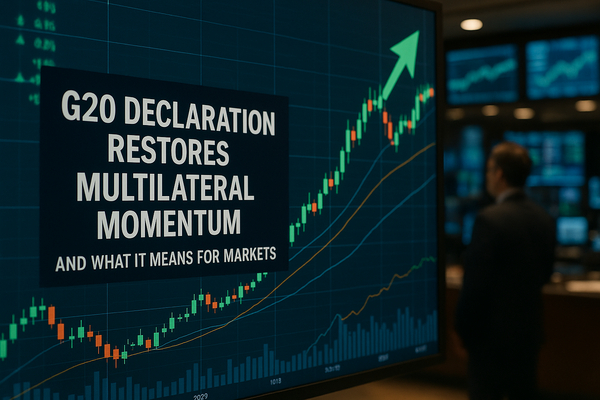
G20 declaration secures multilateral win despite U.S. objections
The G20 issued a joint declaration after South Africa rallied members, overcoming a boycott and objections from the United States. That rare show of unity matters now because it reduces near-term doubts about the forum and may lift risk sentiment in the coming session. In the short term markets will parse the political signal for flows into risk assets and safe havens. Over the long term the outcome could support more coordinated trade and policy approaches that matter for Europe, the United States, Asia and emerging markets. Historically this marks a comeback for multilateralism after recent strains on global forums.
Market opening tone and immediate drivers
How markets open will hinge on the interpretation of the G20 outcome. The declaration represents a collective pushback against fragmentation. Investors may see that as a positive backdrop for risk appetite. However the United States expressed sharp displeasure, and next year it hosts the group. That contrast creates near-term uncertainty about follow-through and policy details.
Short-term drivers will include headlines about whether the declaration contains language on trade, finance or coordination. In addition, traders will watch reactions in equity futures, credit spreads and volatility benchmarks. The political signal is likely to interact with existing market themes and could either amplify risk seeking or increase caution depending on subsequent commentary from major capitals.
Safe havens, yields and currency flows
Bond markets tend to respond swiftly to shifts in geopolitical risk and institutional confidence. A visible thaw in multilateral tension can ease demand for safe assets and put upward pressure on yields. Meanwhile, expressions of U.S. frustration may keep the dollar sensitive to headlines, especially if investors read those comments as a sign of policy friction between Washington and the broader group.
Currency moves will reflect two dynamics at once. One dynamic is a rally in risk-linked currencies if investors take the G20 outcome as reducing fragmentation. The other is episodic dollar strength if U.S. concerns prompt investors to prefer liquidity. Commodities will also react to the tone on trade and cooperation. Any language in the declaration about trade facilitation or supply chains would quickly affect markets that price global demand expectations.
Regional impact: United States, Europe, Asia and emerging markets
In the United States the reaction is political as much as economic. The United States called the outcome infuriating. Markets will monitor how that sentiment translates into posture at next year’s summit when Washington hosts. If U.S. policy makers take a confrontational tone, that could reintroduce caution into asset allocation. If they temper their stance, capital flows into risk assets may accelerate.
For Europe the revived G20 declaration signals potential support for multilateral rules and cooperation. European markets could interpret the moment as a reduced risk of unilateral disruptions to trade and cross border investment, which would be constructive for exporters and financial firms that rely on stable global frameworks.
Asia will watch for language affecting supply chains and trade integration. Economies that depend on open trade and regional links have the most to gain from renewed multilateral engagement. Emerging markets may see the largest relative impact. A coherent G20 message can lower perceived tail risk and attract inflows back into higher beta assets. In addition, collective approaches to global issues can ease funding pressures that have hit some emerging issuers in recent years.
Trading session scenarios and the watch list
Traders should treat the G20 declaration as a headline that can alter intraday positioning. The most likely scenario for the trading session is that risk assets push higher on improved sentiment while safe havens trim earlier gains. However, that move will not be linear. Expect volatility as market participants test the durability of the declaration and seek clarity on whether major economies will align on concrete measures.
Key items to monitor include official statements from the United States and South Africa, follow-on communiques from other large economies, and any market commentary that clarifies whether the declaration touches trade, finance or regulatory coordination. In addition, watch flows into equity futures, sovereign bond yields and currency crosses for the first sign of directional conviction. Credit markets will register even subtle shifts in perceived geopolitical risk and policy coordination.
What history suggests and the path ahead
Historically, G20 cohesion has waxed and waned. Periods of clear cooperation have tended to coincide with smoother risk appetite and tighter global financial conditions. Conversely, visible fractures have amplified volatility and discouraged cross border investment. This declaration represents a momentary reassertion of the multilateral model. Whether it leads to durable policy coordination depends on the follow-up from member capitals and the content of subsequent discussions.
For market participants the prudent stance is to treat the declaration as an important signal but not as a definitive shift in fundamentals. The event matters now because it reduces an immediate source of political uncertainty and because it sets the agenda heading into the next summit when Washington will play host. In the trading session that follows, expect headline-driven moves and a focus on official reactions. Longer term, markets will price the outcome according to whether declarations translate into tangible cooperation on trade and financial policy.
Overall, the G20 declaration offers a constructive backdrop for markets today while leaving ample room for headline risk. Traders should watch reactions across equities, bonds and currencies and track official responses that will determine whether this moment reorders market sentiment or remains a temporary reprieve.












